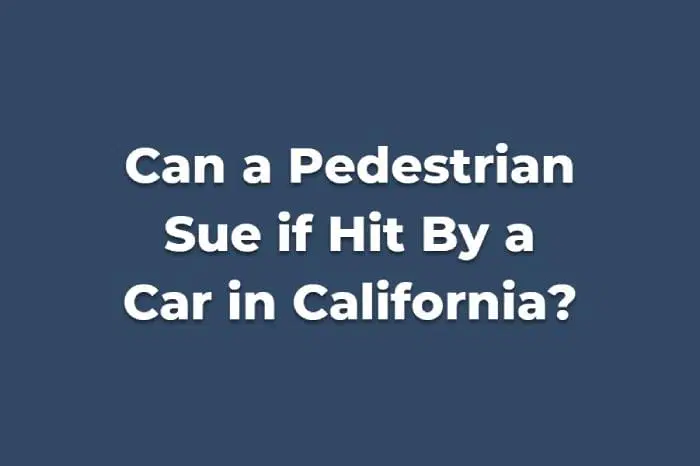
Can a Pedestrian Sue if Hit By a Car in California?
Legally reviewed by: Jessica Anvar Stotz, JD, MBA
Short answer: If you were hit by a car in California as a pedestrian and suffered injuries, you may have the right to sue via a personal injury lawsuit.
California follows a fault-based system, meaning the person responsible for the accident is typically held liable for damages.
To have a successful case, you generally need to prove that the driver was negligent, meaning they failed to exercise reasonable care. This could involve showing that the driver violated traffic laws, was distracted, or acted recklessly.
It’s important to gather evidence such as witness statements, photos of the accident scene, and any medical records related to your injuries. Seeking legal advice from a personal injury attorney who is familiar with California law is crucial to understanding your options and building a strong case.
When You Can & Can’t Sue for Being Hit By a Car as a Pedestrian in California
| Injuries Sustained from Accident | Possibility of a Injury Lawsuit |
| No injuries | No |
| Minor Injuries | Yes |
| Moderate Injuries | Yes |
| Severe Injuries | Yes |
*The information in this table is based on prior pedestrian accidents. Each case is unique and only a personal injury lawyer can inform you if you have a valid case or not.
Potential Compensation for Pedestrian Accident Victims
Use the table below to see what your potential pedestrian accident settlement could be worth.
| Severity of Accident | Average Settlement Amount |
| Low | Approximately: $10,000 – $50,000 |
| Moderate | Approximately: $50,000 – $150,000 |
| High | Approximately: $150,000 – $1,000,000+ |
Estimate What Your Case Could Be Worth
Want to estimate what your case is worth? Use our online settlement estimator below to gauge what your compensation could be.
Liability in California Pedestrian Accident Cases
When Drivers are Liable
In California, drivers are generally expected to exercise reasonable care and follow traffic laws. If a driver fails to do so and hits a pedestrian, they may be held liable for the accident. Common scenarios where drivers might be deemed liable include:
- Failure to Yield: If a driver fails to yield the right of way to a pedestrian at crosswalks or intersections.
- Speeding: If a driver is exceeding the speed limit and cannot stop in time to avoid hitting a pedestrian.
- Distracted Driving: If a driver is distracted by activities like texting, talking on the phone, or other distractions that lead to hitting a pedestrian.
- Driving Under the Influence (DUI): If a driver is under the influence of alcohol or drugs, and this impairment contributes to the accident.
When Pedestrians May be Held Liable
While drivers are often considered more responsible, pedestrians also have responsibilities to ensure their safety. Pedestrians may be held partially or fully liable for an accident if:
- Jaywalking: If a pedestrian crosses the road outside of a crosswalk or against traffic signals.
- Ignoring Walk Signals: If a pedestrian crosses the road against traffic signals, especially when there’s a “Do Not Walk” signal.
- Intoxication: If a pedestrian is under the influence of alcohol or drugs and their impairment contributes to the accident.
- Reckless Behavior: Engaging in reckless behavior, such as running into traffic without warning.
It’s crucial to note that California follows a comparative negligence system, meaning both the driver and the pedestrian can share a degree of fault. In such cases, the damages awarded may be reduced based on the percentage of fault assigned to each party.
Seeking legal advice is important for a thorough understanding of liability in a specific pedestrian accident case.
How You Could Secure a Fair Settlement
Securing a settlement in a pedestrian accident case involves considering various factors. While I’m not a lawyer, here are some common factors that could potentially contribute to a favorable settlement:
- Evidence of Negligence: Providing clear evidence that the driver was negligent and at fault for the accident is crucial. This may include witness statements, traffic camera footage, or any other evidence proving the driver’s failure to exercise reasonable care.
- Medical Documentation: Detailed medical records that document the extent and nature of the injuries sustained can strengthen a case. This includes hospital records, doctor’s notes, and bills related to medical treatment.
- Lost Wages and Future Earnings: If the pedestrian has incurred lost wages due to the accident and has the potential for future income loss because of sustained injuries, documenting these financial losses is important.
- Pain and Suffering: Non-economic damages, such as pain and suffering, emotional distress, and loss of enjoyment of life, can be factored into a settlement. Providing evidence and documentation to support these claims is essential.
- Expert Opinions: Expert opinions, such as those from accident reconstruction specialists or medical professionals, can lend credibility to your case. These experts can provide insights into the cause of the accident or the long-term impact of injuries.
- Insurance Coverage: Understanding the insurance coverage of the at-fault driver is important. This includes knowing the policy limits and the types of coverage available, as it can impact the maximum amount that can be recovered.
- Legal Representation: Having a skilled personal injury attorney who specializes in pedestrian accidents can significantly enhance your chances of securing a favorable settlement. An attorney can navigate the legal process, negotiate with insurance companies, and ensure your rights are protected.
- Communication Skills: Effective communication, both written and verbal, is crucial during negotiations. Clearly presenting your case, supported by the necessary documentation, can strengthen your position during settlement discussions.
- Negotiation Skills: Skillful negotiation is a key factor in securing a favorable settlement. A knowledgeable attorney can negotiate on your behalf, seeking fair compensation for your injuries and damages.
*Remember, each case is unique, and outcomes can vary.
Factors That Could Reduce Possible Compensation
Several factors could potentially minimize the settlement amount in a pedestrian accident case. It’s important to be aware of these factors and take them into consideration when pursuing a personal injury settlement. Some factors that may impact the settlement amount negatively include:
- Comparative Negligence: If the pedestrian is found to have contributed to the accident through actions like jaywalking, crossing against signals, or engaging in reckless behavior, it can reduce the settlement amount. California follows a comparative negligence system, and the settlement may be reduced based on the percentage of fault assigned to the pedestrian.
- Pre-existing Conditions: If the pedestrian had pre-existing medical conditions or injuries that were not caused by the accident, insurance adjusters may argue that the accident did not significantly contribute to the current health issues. This could impact the amount awarded for medical expenses and pain and suffering.
- Lack of Clear Liability: If there is ambiguity or insufficient evidence regarding the driver’s negligence, proving liability becomes challenging. This can lead to a lower settlement offer, as the insurance company may dispute the extent of their policyholder’s responsibility.
- Insurance Policy Limits: The amount of available insurance coverage plays a significant role in determining the settlement amount. If the at-fault driver has minimal insurance coverage, it may limit the funds available for a settlement.
- Inadequate Documentation: Failing to provide comprehensive documentation, such as medical records, accident reports, and evidence of damages, may weaken the case. Insufficient evidence may result in a lower settlement offer.
- Delayed Medical Treatment: If the pedestrian delays seeking medical treatment after the accident, insurance companies may argue that the injuries were not severe or were caused by factors unrelated to the accident. Prompt medical attention and documentation are crucial.
- Inconsistent Statements: Inconsistencies in the pedestrian’s statements, whether to law enforcement or during the claims process, can be used to challenge credibility and may impact the settlement amount.
- Disputes Over Damages: Insurance adjusters may challenge the extent of damages claimed, including medical expenses, lost wages, and non-economic damages. Disputes over the value of these damages can result in a lower settlement offer.
*Remember, each case is unique, and outcomes can vary.
What a Personal Injury Lawsuit Might Look Like if You Decide to Sue
If an injured pedestrian decides to file a personal injury lawsuit, the process typically involves several key stages. Keep in mind that specific details can vary based on the circumstances of each case. Here’s a general overview of what a personal injury lawsuit may look like for an injured pedestrian:
- Consultation with an Attorney: The injured pedestrian would typically begin by consulting with a personal injury attorney. During this initial consultation, the attorney assesses the case’s merits, potential liability, and damages.
- Investigation and Gathering Evidence: The attorney conducts a thorough investigation, collecting evidence to support the pedestrian’s claim. This may include obtaining accident reports, interviewing witnesses, securing video footage, and assessing the extent of the injuries.
- Filing the Lawsuit: If a settlement cannot be reached with the at-fault party’s insurance company, the attorney files a lawsuit on behalf of the injured pedestrian. The lawsuit outlines the legal claims, facts of the case, and the damages sought.
- Service of Process: The defendant (the at-fault party) is served with legal notice of the lawsuit. This includes a copy of the complaint, which details the allegations against them.
- Response from the Defendant: The defendant has a specified period to respond to the lawsuit, usually by filing an answer. This document outlines the defendant’s position and defenses.
- Discovery Process: Both parties engage in the discovery process, where they exchange relevant information and evidence. This may involve written interrogatories, depositions, and requests for documents.
- Mediation or Settlement Negotiations: Before proceeding to trial, the parties may engage in mediation or settlement negotiations to try to resolve the case. A mediator facilitates discussions, and if an agreement is reached, the case may be settled.
- Pre-Trial Motions: The attorneys may file pre-trial motions to address legal issues, such as requests to exclude certain evidence or dismiss parts of the case.
- Trial Preparation: If a settlement is not reached, the case proceeds to trial. Attorneys on both sides engage in intensive trial preparation, including the selection of a jury, gathering expert witnesses, and developing a trial strategy.
- Trial: The trial involves presenting evidence, witness testimonies, and legal arguments to a judge and jury. The jury then deliberates and delivers a verdict.
- Post-Trial Motions and Appeals: After a verdict is reached, either party may file post-trial motions. If dissatisfied with the outcome, they may also choose to appeal the decision.
- Enforcement of Judgment: If the injured pedestrian is successful, the court enters a judgment specifying the damages awarded. The injured party and their attorney then work to enforce the judgment and collect the awarded amount.
Throughout this process, the injured pedestrian’s attorney plays a crucial role in advocating for their rights, presenting a compelling case, and seeking fair compensation for the damages suffered.
Dangers of Filing a Pedestrian Accident By Yourself
Suing after a pedestrian accident without legal representation poses significant risks. Navigating complex legal procedures, dealing with insurance companies, and understanding applicable laws can be challenging.
Self-represented individuals may overlook crucial details, leading to potential legal pitfalls and reduced compensation. Personal injury attorneys possess expertise in building strong cases, negotiating settlements, and addressing unforeseen complexities.
Without professional guidance, individuals risk receiving inadequate compensation and may struggle to navigate the intricacies of the legal process, jeopardizing their chances for a successful outcome in court.
How Insurance Companies Try to Minimize or Eliminate Potential Compensation
Insurance companies often employ tactics to minimize or eliminate potential compensation for personal injury claims. These may include offering low settlements, disputing liability, or downplaying the extent of injuries.
Adjusters may use recorded statements against claimants, searching for inconsistencies. They may also argue pre-existing conditions or delay payments to create financial pressure. By scrutinizing medical records, they attempt to devalue treatment costs. Quick settlement offers may also discourage legal involvement.
To counter these tactics, seeking legal representation is crucial for understanding one’s rights, negotiating effectively, and securing fair compensation in the face of insurance company strategies.
Considering a Personal Injury Lawsuit?
If you’re still considering filing a lawsuit after being hit by a car as a pedestrian, we are happy to help. We work with some of the best pedestrian accident attorneys in the state. Each one offers free initial consultations to help you decide if suing is worth it. Contact us today to see what your case could be worth.


